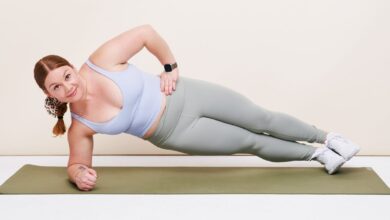Those Squat Pulses Burn Like Fire…But Do They Actually Do Anything!?

Whether you’re in pre-brunch Pilates or your lunchtime HIIT class, you’ve probably been tasked with a certain directive that makes the four-letter words fly (in your head only, of course): Squat! Then…squat pulse!
While you’re dutifully performing those small but spicy movements, you can’t help but wonder—do squat pulses actually do anything!? We’re all for adding a challenging element to uplevel your workout, but it’s key that it actually has a purpose (and just isn’t hard for the sake of being hard). So: Do squat pulses fit the bill? We reached out to the pros to get the lowdown.
What exactly are squat pulses anyway?
A squat pulse is similar to the traditional lower-body compound movement we all know and love, but with a couple tweaks: The range of motion is much smaller and you don’t fully stand up between reps. This move involves both the eccentric (lowering) and concentric (raising) movements of a squat, done in quick succession, but because you won’t come back to start until the very end, your muscles don’t really get a “break”—which is why it can feel so freaking hard to do it even with just your bodyweight.
To perform a squat pulse, start with your feet hip-width apart. Push your hips back and bend your knees to lower down, keeping your chest up and core engaged. Once you’re at the bottom of the squat, rise about half way back up, then drop back down to the bottom position. Quickly repeat this pulsing movement, Brittany Watts, NASM-CPT, head coach at Tone House, tells SELF. You’ll likely do this multiple, multiple, times—in her classes, for 30 seconds straight, after a 30 second hold—and if you do it correctly, your lower body muscles, including your quads, glutes, and hamstrings should be feeling it. (Additionally, your core and calves help stabilize you throughout the movement, so you may feel the burn here as well, Meredith Witte, MS, CSCS, founder and owner of The Playground Fitness, tells SELF.)
You’ll likely encounter squat pulses most frequently in your HIIT, barre, or strength training-based classes, like boot camps. But if you’re not a group fitness fan, no worries, because you can add a pulse to your solo workouts, too. Sydni Arnett, NASM-CPT, a principal instructor at Barry’s Philadelphia, uses the move as a “burnout” at the end of her set when she wants “a little something extra juicy,” as she tells SELF. “I’d add a pulse at the end of a set of 10, for example.”
What are the benefits of squat pulses?
Squat pulses can help build muscular endurance and strength—and can help you gain muscle overall. They do this through a strength training tenet called time under tension (TUT), which simply refers to how long you’re working a muscle during each rep. Because of the added small movements of a squat pulse, your time under tension is going to be higher, since your muscles are firing for a longer time before relaxing than they would if you were doing reps of a regular squat. Plus, since you normally do squat pulses with just your bodyweight or a light weight, this allows you to do more of ‘em, which follows the formula for building muscular endurance.
Like we mentioned above, squat pulses are also great as a finisher after more traditional lower-body strength training. Because the movement is so small and you maintain tension throughout, your muscles remain activated for the entire duration of your reps, which really helps “burn out” the muscle, Arnett says. This supports hypertrophy—the fancy term for muscle growth—due to the added metabolic stress and muscle damage, and also helps you close out your workout on a high(ly sweaty) note.
Are squat pulses just as good as…regular squats?
Before you start dropping it low, consider your goals. Because while squat pulses are in some ways similar to their more traditional cousin, they don’t affect your body in quite the same way.
For one, a full range of motion squat is simply more functional than a squat pulse, says Witte—meaning they better mimic everyday movements like standing up and sitting up.
And when talking about muscle strength and size, time under tension—and that hurts-so-good burn that comes with it—isn’t the be all, end all. With squat pulses, the particular kind of strength you’ll build with squat pulses is muscular endurance. The longer you perform the move, the more you’re challenging those slow-twitch muscle fibers, or the ones that help you work for an extended period of time without tiring, says Arnett.
But if your goal is to build absolute strength (for instance, how much weight you can lift at your one-rep max), a squat pulse likely isn’t going to get you there. That’s because the protocol for max strength gains includes heavy weight, low reps, and the squat pulse (which usually has you performing a whole bunch of reps with lower weight or just your bodyweight) isn’t conducive to that. On the other hand, a regular squat—whether we’re talking a barbell back squat, a goblet squat, or any other variation you can load—can come in clutch here, since you can go so heavy you can only eke out a couple reps. You’re also able to use progressive overload with OG squats. By continually upping your weight and challenging your glutes, quads, and hammies to lift more over time, you’re creating tiny tears in the muscle that mend back together and become stronger.
Finally, if you really want to max out muscle gain, a full range of motion is probably going to be a better bet compared to a limited ROM (like what you’d get with a squat pulse), says Witte. In fact, according to a 2020 review, strength training through the full range of motion is likely better for growth of your lower-body muscles. (And if you slow it down, even better: Research published in Fronters of Physiologist suggests that a slower tempo during a full range of motion squat can help build muscle and strength.)
All this holds true even though the squat pulses burn so freaking bad: In fact, it’s important to recognize this uncomfortable feeling due to the sustained tension is not a direct indicator of muscle growth, says Witte. “To effectively build muscle, you need to focus on progressive overload and training close to muscular failure.”
All this isn’t to say that the squat pulse shouldn’t have a place in your workout routine, though. Because it doesn’t require heavy weight, it might be a better choice for those who want to work hard, but are newer to strength training or those building back strength after a hiatus. “The goal here is to maintain high muscle engagement and increase workout intensity without having to increase load,” Watts says. What’s more, because of the quick nature and duration of the move, it can help athletes build coordination and explosive strength, even without lots of external weight.
And while many folks program explosive or jumping-based moves as finishers to their workout, those who have joint issues or who need to avoid high-impact exercises might be left looking for an alternative. Enter, the squat pulse: Like we discussed earlier, this can be a great, lower-impact way to burn out your muscles, says Watts.
Squat pulses can also have a place in your workout as a “hero” moment, helping you end a gym session feeling strong. Arnett says she programs the move in her classes to build to the final moments of a workout—and she incorporates it in her own when she wants to finish on a note that makes her feel like she really crushed it. Adding this final low-impact burst of effort at the end of your routine can simply help you feel physically and mentally tough.
Here’s the bottom line on squat pulses.
Squat pulses certainly can have a place in your program, and if your goals line up with the benefits they confer, it can be a match made in workout heaven. If you want a simple, equipment-free way to bring challenge to your routines that really makes you feel like you left it all out there, squat pulses can be a nice add.
Even if everything doesn’t match up completely, you still don’t need to stop doing them—particularly if you enjoy them! After all, you want to have fun while sweating (or at the very least, not completely hate your life) so you keep coming back for more.
What’s more, it doesn’t need to be an either/or situation with squat pulses and traditional squats. Even if the main benefits of squat pulses don’t fit in with your particular strength goals, they can be a great supplement to more traditional strength training, says Witte. In this case, you might want to add them in as a drop set after regular squats (where you reduce the weight and perform the move to failure) or simply to mix up your routine. For instance, if you’re bored with a traditional squat, try incorporating a banded squat pulse, or changing up your foot position—say, a sumo squat with pulse, or a narrow squat with a pulse—for an added challenge.
But if you find yourself dreading the squat pulse, and would really rather spend your exercise effort somewhere else—particularly if you’re uber-focused on max muscle or strength gains and would rather devote your time to that—consider it something you can cross off your list. There are tons of other ways to work your butt (and lots of squat variations out there!) that you may find a better fit.
Related:
- Do I Get a ‘Better’ Cardio Workout If I Go Faster or Longer?
- 19 Signs Your Fitness Routine Is ‘Working’ That Have Nothing to Do With Weight Loss
- Does Pilates ‘Count’ as Strength Training?
Get more of SELF’s great fitness content delivered right to your inbox.



